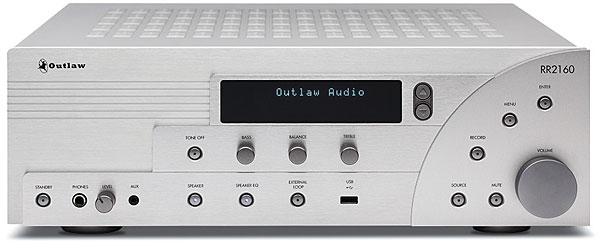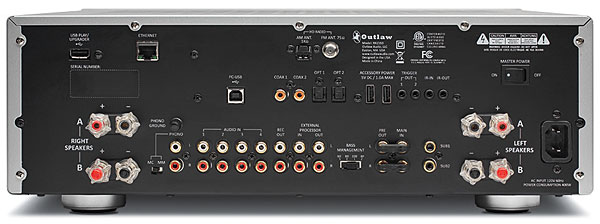This thing ways more than many, many 7.2, even 9.2 channel AVRs out there. It has all the features anyone could need- including USB DAC which is very rare on home theater receivers. Any one know what it uses for internet radio? vTuner, Tune-in .... etc?
Outlaw RR2160 Stereo Receiver Review

AT A GLANCE
Plus
110 watts x 2
PC-USB and phono inputs
Bass, treble, balance
controls
Minus
No HDMI or other video switching
Ethernet but no Wi-Fi or Bluetooth
THE VERDICT
Although not an AVR, Outlaw’s second-generation stereo receiver has an intelligently chosen feature set, bodacious industrial design, and lots of clean power for music lovers on a budget.
One might argue that no single product category has brought vastly improved sound to so many, so fast, as the now-retro stereo receiver. Models poured in during the (mostly) Japanese mass-market audio explosion of the 1970s, when Classic Rock was just rock. My first receiver was a 15-watt-per-channel Pioneer SX-434, but it just as easily could have been a Marantz, Sansui, Kenwood, Luxman, or any of several other storied brands. Today, top-line stereo receivers from the ’70s—their shiny silver faceplates bristling with knobs, buttons, and toggles—command eyebrow-raising prices on eBay and are lovingly restored by vintage hi-fi buffs.
Outlaw Audio speaks with an American accent and belongs more to our own era, selling direct to the consumer over the internet—thus potentially offering better build quality and value by eliminating the brickand-mortar markup. But while history may not repeat itself, sometimes it rhymes, and the impecunious music lover seeking a good stereo amplifier has a lot in common with his counterpart back in the heart of the original vinyl era. The main difference is that today’s music lover may also want to plug in a laptop or groove to internet radio. The Outlaw RR2160 makes that possible, too.
Take Two
The RR2160 is Outlaw’s second-generation stereo receiver. Other Outlaw products include seven-channel, five-channel, and monoblock amps. The company’s surround pre/pro is five years old, but the Outlaw retail site carries a more up-to-date Marantz for one-stop separates shopping. Also under the Outlaw umbrella are two subwoofers (one of them THX certified) and numerous small products and accessories.

The RR2160’s predecessor was the very successful RR2150, the senior member of Outlaw’s line at the time of its retirement. But the new receiver differs from it in several ways, large and small. The aluminum front panel is thicker. Front-panel controls have been updated from analog potentiometers (which oxidize and grow noisy over time) to digital rotary encoders (much like the volume knob on an AVR). Most features are now remote accessible. Digital coaxial and optical audio inputs have been added, along with a second monophonic subwoofer output, USB charging, and 12-volt triggers. An Ethernet jack allows DLNA and internet radio access; digital over-the-air HD Radio has been added to the AM/FM tuner.
We needn’t dwell on the fact that, because this isn’t an A/V receiver, it doesn’t have a standard AVR feature set. It has two channels of amplification, with no video switching, surround processing, auto setup, room correction, etc. It’s rated at 110 watts x 2 into 8 ohms (that’s up from 100 in the previous model) and 165 watts into 4 ohms. This should be sufficient to run speakers that are slightly less sensitive than average, with power to spare in many rooms.
The receiver comes safely packed in a dual carton with seemingly indestructible foam. Evoking the silver-faceplate aesthetic of the ’70s—with an unorthodox dash of Art Deco—it wears its knobs and buttons proudly. Front-panel occupants include defeatable treble, bass, and balance controls, a three-setting bass boost called Speaker EQ, a variable headphone output, and a few others. The treble control operates at 10 kilohertz ±10 decibels, the bass control at 50 hertz ±10 dB, and the Speaker EQ provides a 6-dB boost at 55, 65, or 80 Hz. The front panel’s right-hand partition, marked by a stylishly curved diagonal slash, contains the volume knob and buttons for mute, source select, and recording source, as well as those to operate the modest setup menu utilizing only the front-panel display. The menu is nothing like an AVR’s vast compendium of options; you might never need to enter it at all. This product will be literally plug and play for many users.
On the back are enough binding posts to allow connection of two pair of speakers, switchable via front panel or remote. There is no HDMI interface; you may connect the audio portions of A/V products via coaxial, optical, or analog inputs, but video switching must go through the TV. There are, however, two subwoofer outputs if you’re in the mood for home theater 2.1, plus a sub crossover switch that provides analog bass management and toggles among 60/80/100 Hz and bypass options. The aforementioned phono input accommodates either moving-magnet or moving-coil cartridges.
Stereo preout and main-in RCA jacks allow connection of an external amp (not likely to be needed), crossover, or equalizer; supplied bridges are pre-installed between them for the default direct connection. There’s also a set of classic external loop jacks to accommodate a tape deck. Want me to explain the difference between Dolby B and Dolby C noise reduction in a cassette deck? I could, y’know. Just asking.
 Radio options span the generations: AM, FM, HD Radio, internet radio. Meanwhile, Ethernet, IR remote, trigger, and USB accessory power are also provided for. Wi-Fi and Bluetooth are not (although Outlaw does offer various wireless accessories). You
can access music from any networked PC or other device via Ethernet-supported DLNA, or you can plug a storage device into the front-panel USB jack. And I’ll say it again: You can plug a laptop into the receiver, via the back-panel PC-USB input, and that’s cause for celebration. (That this isn’t a standard feature in top-line AVRs is a perpetual disappointment.)
Radio options span the generations: AM, FM, HD Radio, internet radio. Meanwhile, Ethernet, IR remote, trigger, and USB accessory power are also provided for. Wi-Fi and Bluetooth are not (although Outlaw does offer various wireless accessories). You
can access music from any networked PC or other device via Ethernet-supported DLNA, or you can plug a storage device into the front-panel USB jack. And I’ll say it again: You can plug a laptop into the receiver, via the back-panel PC-USB input, and that’s cause for celebration. (That this isn’t a standard feature in top-line AVRs is a perpetual disappointment.)
The remote control is backlit and has a nice heft, thanks to its all-metal construction. However, it’s dominated by seemingly uninterrupted rows and columns of nearly identical buttons and doesn’t work hard enough to organize controls by size, shape, or layout. The volume keys in particular are undersized and too well camouflaged. The first time I used the remote, it took me 10 seconds to find them (and this hadn’t been a problem with the RR2150’s remote). The diagram in the manual shows some groups of controls set off by background shading, but the shading, mysteriously, doesn’t appear on the remote itself. As beautiful and easy to use as the receiver is, I had to dock it an ergonomics point for the remote.
Associated equipment included two, just two, Paradigm Reference Studio 20 v.4 speakers with a Paradigm Seismic 110 sub (a nifty little 10-inch bruiser for which I continue to give thanks). Signal sources included an Oppo BDP-83SE universal disc player, connected to the system via both its Special Edition analog and digital coaxial outputs. The player was set to stereo downmix, which Outlaw’s bass management obligingly delivered in 2.1. The player’s coax-out was set to PCM, since this non-surround receiver doesn’t decode Dolby or DTS bitstreams. SACD priority was set to stereo (avoiding multichannel). I also used a Micro Seiki BL-51 turntable (the larger of two, nicknamed Micro Senior) and a Shure M97xE (moving magnet) cartridge.
File Under Chameleon
The RR2160 doesn’t impose an overwhelming personality on content. Neutral voicing is a good thing: Not evasive but truthful, it opens a window into music and reliably gauges the quality of source components. This beefy stereo receiver took control of my speakers of average sensitivity with dynamic confidence, giving rhythm sections a reliable firmness. I had the option of playing loud or louder without fretting about any tradeoff between volume and comfort; the top end retained its refinement at any volume I could withstand in my room.
- Log in or register to post comments

An essay writing service can help you master how to write a visual analysis. Find expert guidance right here. Academic writing services are essential for improving your writing skills and achieving better academic results.































































